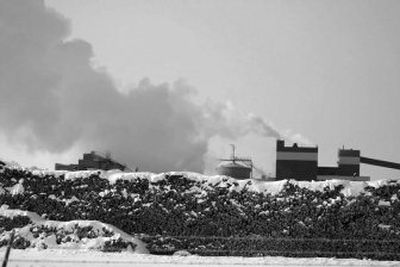Forests in far North key to rising temps

PINE FALLS, Manitoba – Here on the edge of the silent and frozen northern tier of the Earth, the fate of the world’s climate is buried beneath the snow and locked in the still limbs of aspen trees.
Nearly half of the carbon that exists on land is contained in the sweeping boreal forests, which gird the Earth in the northern reaches of Canada, Alaska, Scandinavia and Russia. Scientists fear that the rising temperatures in the atmosphere and the increasing human activity in those lands are releasing that carbon, a process that could trigger a vicious cycle of even more warming.
Scientists are only starting to understand the forces which could free vast stores of carbon and methane that have been collecting since the last ice age in the frozen tundra and northern forests. Scientists believe that would push the world’s climate toward a heat spiral that would raise ocean levels, spawn fierce storms and scorch farmlands.
But the land could also be enlisted to help abate global warming, as both a storehouse for man-made carbon dioxide and a natural sponge for greenhouse gases. Policymakers are considering changes to protect and expand the forested areas that store carbon; outside the boreal forest, they are experimenting with techniques to bury man-made carbon dioxide in underground vaults and porous seams.
“The world is both victim of climate change and a possible solution to it,” said Stewart Elgie, associate director of the Institute of the Environment at the University of Ottawa.
Carbon is freed from the land in numerous ways. Permafrost is melting because warmer weather exposes peat, deadwood and buried pine needles to decay, freeing the carbon they contain. Fires, raging through forests more often because of hotter and drier weather, send wood – and its carbon – up in smoke. Insects thriving in milder winters girdle trees and send them to rot on the forest floor. Miners and oilmen build roads that expose the earth and warm the land, and loggers cut down old forests and replace them with young ones that will take decades of growth to absorb and store the released carbon.
As the released carbon rises, it adds to the belt of greenhouse gases in the atmosphere, trapping even more heat, which boosts temperatures. Scientists call it a “feedback loop.” Others refer to it as the carbon time bomb.
Scientists acknowledge they are not certain how the carbon time bomb will explode, or when. Many of the consequences of global warming that experts once predicted would take centuries are occurring in decades, such as the melting of the world’s glaciers and ice caps. But other changes might be more gradual.
“With permafrost, it may take longer for change to get moving. But it may keep moving, even if we get our emissions under control,” said Antoni Lewkowicz, a professor of geography at the University of Ottawa.
There are mixed views about whether the process can be stopped. The levels of carbon dioxide in the atmosphere – the highest in at least 420,000 years – mean average temperatures will continue to rise, accelerating the thawing.
But humanity’s footprint could be changed. Development, mining and logging account for 25 percent of the carbon loss in forests, Elgie said. Logging releases almost twice as much carbon dioxide each year as all the passenger vehicles in Canada, he said.
South of the great swath of forest in central Canada, the wrinkles of the land smooth out, stretching toward a straight horizon. The Great Plains are frozen and still in winter. But in Weyburn, 70 miles southeast of Saskatchewan’s capital, Regina, pumps bob relentlessly amid the snowy wheat fields, sucking crude oil from a mile underground.
What goes back into the ground here heartens some environmentalists. The giant EnCana oil and gas company, which operates more than 700 oil pumps in this field, pumps carbon dioxide deep down to drive more oil out of the porous rocks.
Almost inadvertently, the company has become the world’s largest working example of carbon storage, or sequestration, a technique being hailed by international experts as one tool to reduce greenhouse gases. Darcy Cretin, operations superintendent at the EnCana plant, is slightly amused by the environmental scientists who have flocked here.
“We have to keep explaining we are doing this to make more oil,” he said. “The carbon sequestration is an extra.”
When the oil brought up at Weyburn dwindled after 40 years of pumping, EnCana struck a deal with the Dakota Gasification Co. It owns a plant in Beulah, N.D., that converts coal to natural gas. Combustion at the gasification plant makes carbon dioxide, which was being vented into the air. EnCana offered to buy the gas, and in 1999, the U.S. company built a 200-mile pipeline into Canada. The foot-wide pipe emerges from its underground route at a chain-link fence on the edge of EnCana’s property.
The company pumps the carbon dioxide under high pressure into the oil field. The gas acts as a kind of solvent, driving the oil out of porous rock. The greenhouse gas remains underground, leaving buried nearly 5,000 tons a day that would otherwise have gone into the atmosphere.
Experts believe this scheme of carbon storage could be used more widely in cases where the gas could be easily collected and moved, such as big power plants or industrial areas. Nearly 40 percent of the carbon dioxide released to the air comes from these sources.